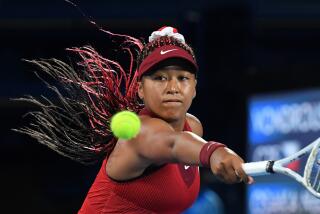Rinaldi Beating the Odds
- Share via
The youngest person ever to join the pro tennis circuit has mixed emotions about proposals to make it harder now for teen-agers to enter the tour.
“What’s good for me isn’t necessarily good for someone else,” Kathy Rinaldi says. “It depends on that person.”
Rinaldi was just 14 when she began play on the Women’s Tennis Assn. tour four years ago.
A special commission of the International Tennis Federation now says that’s too young. It has recommended that the pro tours be closed to anyone under 14, and that players between 14 and 16 be restricted to a certain number of tournaments a year.
The fear is that players who turn pro at such tender years might burn out their bodies or their minds too quickly. Critics point to cases such as Tracy Austin, twice a U.S. Open champion in her teens who has been sidelined for several years now with back problems, and Andrea Jaeger, once ranked in the top five in the world but just now coming back from a nine-month absence from tennis spent restoring her body and enjoying other pursuits.
Rinaldi, meanwhile, has kept rolling along, although her road has traveled both upward and downward.
Currently ranked 15th in the world, Rinaldi was the youngest to win a match at Wimbledon (14 years, 91 days), the youngest semifinalist in the history of the French Open and made it to the final 16 at the 1981 Women’s Tennis Association Championships three months before she officially turned pro.
“My first year on the tour was very special to me,” she said. “I did very well, I was the youngest to do certain things. I wouldn’t change it.”
Great things were predicted of Rinaldi after her initial success. Many predicted she would succeed Austin and Jaeger as a tennis whiz kid.
But after her first year, Rinaldi’s play was more failure than phenom.
Her best showings in 1982 were runner-up finishes at the San Diego WTA stop and the German Open, and a fourth-round elimination at the U.S. Open.
That kind of career roller-coaster is what the ITF commission is worried about.
“Kathy Rinaldi is typical of most young players on the pro circuit,” said Trish Faulkner, WTA player services director and member of the special panel that proposed the ban. “There is no pressure the first year, nobody is used to them and it can lead to some success. The second year on the circuit, everybody is used to them and knows their style.”
Rinaldi first appeared on the WTA computer at 181 in February 1981. By 1982, she had rocketed to 12th before slipping to 16th in 1983.
During the past season she established herself among the top 15 by beating top ranked Helena Sukova (4), Claudia Kohde-Kilsch (9), Hana Mandlikova (3) and Zina Garrison (7).
She topped off one of her best seasons with a semifinal berth in the WTA Championships before falling to Sukova.
“Because of the fact that she wasn’t No. 3 in the world like Chris (Evert Lloyd) or Tracy, people were putting her down,” said Susan Mascarin, 21, Rinaldi’s best friend on the tour. “She’s playing better now and going at her own pace.”
“I knew that was going to happen,” Rinaldi admitted. “Everybody was going to compare, that was expected. I don’t resent it at all. During the first year, everything was great. You have to be willing to accept the pressure.”
That’s why Rinaldi isn’t sure an age limit is the answer.
“It just depends on the individual,” she said. “I think everything you go through helps you. Sure, there are days that I don’t want to go out and practice, but if you keep everything well balanced. . . . “
More to Read
Go beyond the scoreboard
Get the latest on L.A.'s teams in the daily Sports Report newsletter.
You may occasionally receive promotional content from the Los Angeles Times.










